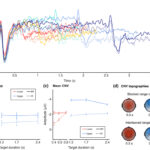A recent study, led by our former team member, Dr. Cemre Baykan, titled “Blocked versus interleaved: How range contexts modulate time perception and its EEG signatures,” investigates how the range of time intervals influences our ability to estimate time accurately. We explored the central tendency and range effects – a phenomenon where time estimations attracted toward the midpoint of intervals – and its underlying neural processes. Using a combination of behavioral tests and electroencephalographic (EEG) measures, we exposed participants to two different setups: blocked-range (BR) and interleaved-range (IR) sessions. The BR session presented short and long intervals in separate blocks, while the IR session randomly mixed intervals of various lengths.
The findings revealed that the BR context led to more accurate time estimates compared to the IR context. Notably, the BR context resulted in a quicker buildup of contingent negative variation (CNV), a brainwave associated with temporal anticipation and preparation for action. This buildup also reached higher amplitude levels and dissolved more rapidly during the encoding stage of the task. Additionally, we observed an enhanced amplitude in the offset P2 component of the EEG signal, another indicator of time processing. These results suggest that the variability in time intervals, as defined by their range, significantly influences the neural processes underlying time estimation.
The full study can be accessed at the Wiley Online Library via the following link: https://onlinelibrary.wiley.com/doi/10.1111/psyp.14585.




